How to Fertilize Watermelons: Enhance Your Harvest with Expert Techniques
- May 22, 2024
- 0 comment
Learn how to fertilize watermelons with expert techniques to maximize yield. Achieve bigger, tastier results in your garden. Growing watermelons can be incredibly rewarding, especially when you harvest large, juicy fruits that are the envy of every gardener. The key to achieving such spectacular results lies not just in how you plant or water your melons, but predominantly in how you fertilize them.
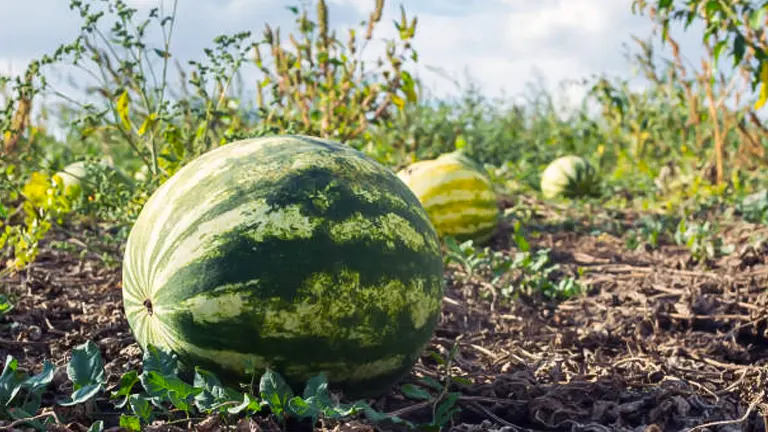
In this guide, we’ll dive into expert techniques for fertilizing watermelons, ensuring you maximize yield and enjoy the sweetest, biggest watermelons you’ve ever grown. Let’s get started on transforming your watermelon patch into a bountiful oasis.
Table of Contents
- Understanding Watermelon Nutrient Needs
- Pre-Planting Soil Preparation
- Planting Density and Arrangement
- Fertilizer Types and Their Benefits
- Timing and Techniques on How to Fertilize Watermelons
- Pruning Techniques for Optimal Growth
- Common Mistakes to Avoid in Fertilizing Watermelons
- Safety and Environmental Considerations
- Conclusion
- FAQs
Understanding Watermelon Nutrient Needs
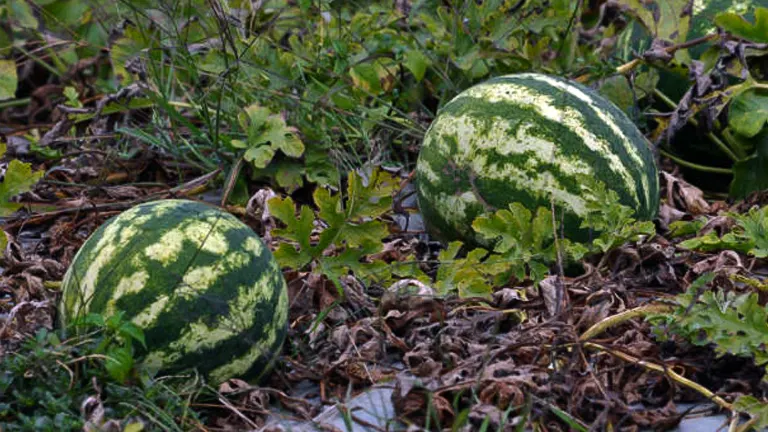
Watermelons, like all crops, thrive when provided with a precise balance of nutrients. The growth and health of watermelon plants hinge on three primary macronutrients: Nitrogen (N), Phosphorus (P), and Potassium (K). Each plays a vital role at different stages of the plant’s life cycle:
- Nitrogen (N) is critical for the development of green, leafy vegetation and is most crucial during the early vegetative growth phase. Nitrogen accelerates the growth of leaves and stems, which are essential for photosynthesis and the plant’s energy production. An optimal range for nitrogen in watermelon cultivation is typically between 80 to 120 kg/ha, depending on the soil’s initial nutrient status.
- Phosphorus (P) facilitates robust root development and is vital for the early growth stage and flowering period. It plays a significant role in energy transfer within the plant, helping to stimulate root development and bloom formation. Watermelon plants generally benefit from phosphorus levels of about 40 to 60 kg/ha.
- Potassium (K) enhances plant health by regulating water and nutrient flow in cells, strengthening plant resilience against diseases and environmental stresses. During the fruit development phase, potassium is crucial as it improves the quality and size of the fruits. The recommended potassium application for optimal fruit quality ranges from 100 to 150 kg/ha.
Besides these macronutrients, watermelons require several important micronutrients, which, though needed in smaller quantities, are essential for preventing disease and ensuring high-quality fruit development:
- Magnesium (Mg) is vital for chlorophyll production and helps in the photosynthesis process.
- Calcium (Ca) strengthens the cellular structure of plants, enhancing overall plant growth and durability.
- Boron (B) is crucial for improving cell wall formation and helps in the efficient transport of sugars across the plant, vital for fruit sweetness.
A scientific approach to fertilization involves not only knowing how much of each nutrient to apply but also understanding the interaction between these nutrients and the plant’s developmental stages.
Nutrient Application Table for Watermelons
| Nutrient | Role in Plant Development | Recommended Application Rate (kg/ha) |
|---|---|---|
| Nitrogen (N) | Promotes leaf and stem growth | 80-120 |
| Phosphorus (P) | Supports root and flower development | 40-60 |
| Potassium (K) | Regulates water, enhances fruit quality | 100-150 |
| Magnesium (Mg) | Essential for photosynthesis | 20-30 |
| Calcium (Ca) | Strengthens plant cellular structure | 50-70 |
| Boron (B) | Improves fruit sweetness, cell wall formation | 0.3-0.5 |
Pre-Planting Soil Preparation

Proper soil preparation is the cornerstone of successful watermelon cultivation. The journey to a bountiful harvest begins with understanding and optimizing your soil’s characteristics to provide an ideal growing environment.
Conducting a Soil Test
The first crucial step in soil preparation is conducting a comprehensive soil test. This test provides detailed insights into the soil’s pH level, nutrient content, and composition. The optimal pH range for watermelon soil is between 6.0 and 6.8. Within this range, essential nutrients are readily available to the plants, and microbial activity is at its peak, promoting healthy growth.
Adjusting Soil pH
Soil pH directly influences nutrient availability:
- If the soil is too acidic (pH < 6.0): Apply lime (calcium carbonate) to raise the pH. The exact amount depends on the initial pH and soil type. For instance, sandy soils might need about 1 ton of lime per acre to adjust pH by 1 unit, while clay soils may require up to 3 tons per acre.
- If the soil is too alkaline (pH > 6.8): Use sulfur or sulfur-containing compounds to lower the pH. For example, it typically takes about 300-500 lbs of sulfur per acre to reduce the pH by one unit, depending on soil composition.
Enhancing Soil Structure and Nutrient Content
Incorporating organic matter such as compost or well-rotted manure significantly improves soil structure and nutrient content. Organic matter enhances water retention, aeration, and microbial activity, all of which are critical for watermelon growth. Aim to incorporate 2-3 inches of organic matter into the top 6-12 inches of soil.
Essential Soil Amendments
Beyond pH adjustment, consider the following amendments based on soil test results to address specific nutrient deficiencies:
- Nitrogen (N): If deficient, apply a nitrogen-rich amendment like blood meal or urea. However, nitrogen should be carefully managed to prevent over-fertilization, which can lead to excessive leaf growth at the expense of fruit development.
- Phosphorus (P): If levels are low, bone meal or rock phosphate can be used to boost phosphorus availability, critical for root development.
- Potassium (K): Potassium sulfate or wood ash can be used if potassium is deficient, supporting overall plant health and fruit quality.
Preparing the Soil Bed
Creating a well-prepared seedbed is essential for watermelon seedlings to establish quickly and grow robustly. Here are the steps:
- Tilling: Till the soil to a depth of at least 12 inches to break up compacted layers, improving root penetration and drainage.
- Leveling: Ensure the soil surface is level to promote uniform water distribution.
- Forming Raised Beds: Raised beds (6-12 inches high) are beneficial, especially in areas with heavy rainfall or poor drainage. They warm up faster in the spring, improve drainage, and enhance root growth.
Soil Amendments for Watermelons
| Amendment | Purpose | Application Rate | Notes |
|---|---|---|---|
| Lime | Raise soil pH | 1-3 tons/acre | Amount depends on initial pH and soil texture |
| Sulfur | Lower soil pH | 300-500 lbs/acre | Gradually lowers pH; avoid over-application |
| Compost | Improve soil structure | 2-3 inches | Incorporate into top 6-12 inches of soil |
| Blood Meal | Increase nitrogen | 10-20 lbs/1000 sq ft | Use sparingly to prevent over-fertilization |
| Bone Meal | Increase phosphorus | 10-20 lbs/1000 sq ft | Slow-release, good for root development |
| Potassium Sulfate | Increase potassium | 5-10 lbs/1000 sq ft | Supports fruit development and disease resistance |
Scientific Analysis
Studies have shown that optimal soil pH (6.0-6.8) enhances nutrient uptake efficiency by up to 25%, leading to more vigorous plant growth and higher yields. Moreover, incorporating organic matter can increase soil organic carbon content by 2-3%, significantly improving water retention and microbial activity, essential for nutrient cycling and plant health.
By meticulously preparing your soil and ensuring the correct balance of pH, nutrients, and organic matter, you set a strong foundation for your watermelon plants to thrive, leading to a productive and healthy crop.
Planting Density and Arrangement
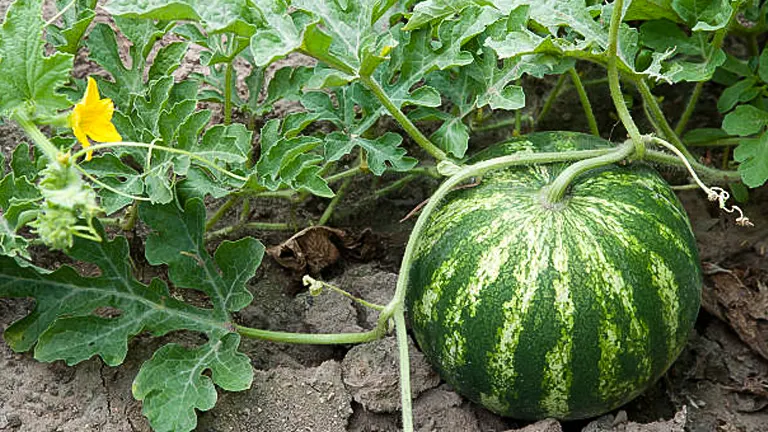
Proper spacing is critical for the healthy growth and maximum yield of watermelon plants. Optimal planting density ensures each plant receives sufficient resources, such as sunlight, water, and nutrients, while minimizing competition and reducing disease risk.
Recommended Spacing for Watermelons
For medium to high-density watermelon farming, the following spacing guidelines are recommended:
- Plant-to-Plant Distance: Approximately 2 feet (60 cm) within rows.
- Row-to-Row Distance: 6 to 8 feet (1.8 to 2.4 meters) between rows.
This arrangement allows ample space for each plant to spread out and for the vines to grow. Adequate spacing ensures proper air circulation and sunlight exposure, which are essential for photosynthesis and reducing the risk of fungal diseases.
Importance of Proper Spacing
- Air Circulation: Good air flow helps in reducing humidity around the plants, thereby decreasing the likelihood of fungal infections such as powdery mildew and downy mildew.
- Sunlight Exposure: Proper spacing ensures that all plants receive adequate sunlight, which is crucial for photosynthesis and overall growth.
- Ease of Management: Adequate spacing makes it easier to manage practices such as fertilization, irrigation, and pest control, ensuring each plant receives the necessary care.
High-Density Planting Techniques
When employing high-density planting techniques, precision in spacing and regular maintenance are crucial to prevent overcrowding and maintain plant health:
- Trellising: Using trellises or support structures can help manage space more efficiently. Trellising keeps the vines and fruits off the ground, reducing the risk of soil-borne diseases and pest infestations. It also promotes better air circulation and exposure to sunlight.
- Pruning: Regular pruning of excess vines and leaves ensures that the plant’s energy is directed towards fruit production. This practice can significantly improve the quality and size of the watermelons.
Scientific Analysis of Planting Density
Research has shown that optimal planting density can significantly impact yield and fruit quality. Studies indicate that watermelons grown with adequate spacing (2 feet within rows and 6 to 8 feet between rows) produce larger fruits and have a higher total yield compared to those grown in overcrowded conditions. Proper spacing also reduces the incidence of diseases, leading to healthier plants and better-quality produce.
Recommended Planting Density and Benefits
| Planting Aspect | Recommended Spacing | Benefits |
|---|---|---|
| Plant-to-Plant | 2 feet (60 cm) | Reduces competition for resources, improves air circulation |
| Row-to-Row | 6 to 8 feet (1.8 to 2.4 meters) | Ensures adequate sunlight exposure, facilitates management |
| Trellising | Use support structures as needed | Promotes healthier growth, reduces disease risk |
| Pruning | Regularly remove excess vines | Directs energy to fruit production, improves fruit quality |
Additional Considerations
- Soil Health: Regularly rotate crops to prevent soil depletion and reduce the buildup of soil-borne diseases. Crop rotation can also improve soil fertility and structure.
- Irrigation: Ensure consistent and adequate watering, particularly during dry spells. Drip irrigation systems are highly effective in high-density setups, as they provide targeted watering with minimal waste.
- Mulching: Apply organic mulch around the base of the plants to retain soil moisture, regulate temperature, and suppress weeds.
By adhering to these spacing and arrangement guidelines, farmers can optimize the growth conditions for watermelon plants, leading to improved yields and better fruit quality. Proper planning and maintenance are essential to achieve the best results in both medium and high-density farming setups.
Fertilizer Types and Their Benefits

Selecting the right fertilizer is crucial for the healthy growth and productivity of watermelon plants. The choice between organic and synthetic fertilizers depends on the specific nutrient needs identified through soil testing and the growth stage of the plants.
Organic Fertilizers
Organic fertilizers, such as composted manure, bone meal, or fish emulsion, are favored for their slow-releasing properties and ability to improve soil structure. They provide a steady supply of nutrients over an extended period, which is beneficial for sustained plant growth. Additionally, organic fertilizers enhance microbial activity in the soil, aiding in the natural breakdown of organic matter and improving nutrient absorption.
- Composted Manure: Rich in nitrogen, phosphorus, and potassium, it also improves soil texture and water retention.
- Bone Meal: High in phosphorus, it supports root development and flowering.
- Fish Emulsion: Provides a balanced nutrient profile with quick-release nitrogen for early growth stages.
Synthetic Fertilizers
Synthetic or chemical fertilizers are often selected for their immediate nutrient availability, which is essential during peak growth phases. These fertilizers are formulated to meet specific nutrient requirements and are labeled with an N-P-K ratio that indicates the percentage of nitrogen (N), phosphorus (P), and potassium (K).
- High-Nitrogen Fertilizers (e.g., 30-10-10): Ideal for the early stages of growth to promote leaf and stem development.
- Balanced Fertilizers (e.g., 10-10-10): Suitable for overall growth and maintenance.
- High-Potassium Fertilizers (e.g., 10-10-30): Crucial during the fruiting stage to enhance fruit size and sweetness.
Environmental Impact Considerations
When choosing fertilizers, it is essential to consider their environmental impact. Organic fertilizers generally have a lower environmental footprint, supporting sustainable farming practices. In contrast, synthetic fertilizers require careful handling to prevent nutrient runoff, which can lead to soil and water pollution. Proper application techniques, such as precision placement and timing, can mitigate these risks.
Combination Fertilization Strategy
A combination of both organic and synthetic fertilizers often yields the best results in watermelon cultivation. An initial application of a balanced synthetic fertilizer can stimulate early growth, followed by regular top-ups with organic fertilizers to maintain nutrient levels and soil health.
Comparison of Fertilizer Types
| Fertilizer Type | Key Nutrients Provided | Benefits | Application Rate | Environmental Impact |
|---|---|---|---|---|
| Composted Manure | N, P, K, organic matter | Improves soil texture, slow release | 20-30 tons/acre | Low, enhances soil health |
| Bone Meal | High in P | Supports root and flower development | 2-3 lbs/100 sq ft | Low, sustainable |
| Fish Emulsion | Balanced N, P, K | Quick-release, boosts early growth | 3-4 tbsp/gallon of water per plant | Low, boosts microbial activity |
| High-Nitrogen (30-10-10) | High in N | Promotes leaf and stem growth | 1-2 lbs/1000 sq ft | Moderate, risk of runoff |
| Balanced (10-10-10) | Equal N, P, K | Overall growth and maintenance | 1-2 lbs/1000 sq ft | Moderate, requires careful application |
| High-Potassium (10-10-30) | High in K | Enhances fruit size and quality | 1-2 lbs/1000 sq ft | Moderate, potential for soil buildup |
Timing and Techniques on How to Fertilize Watermelons
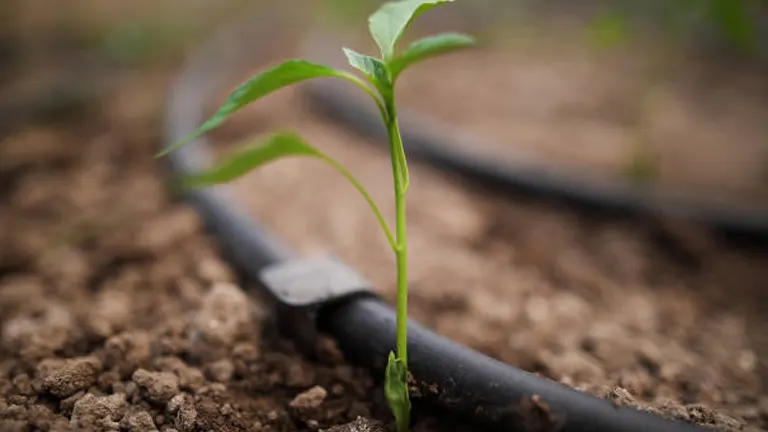
Effective fertilization of watermelons involves not only what you apply but also when and how you apply it. Proper timing and techniques are essential to ensure that nutrients are absorbed efficiently, promoting healthy growth and maximizing yield. The fertilization schedule can be broken down into three critical phases:
At Planting
Starting with a balanced fertilizer that promotes root growth is essential. A formula with a slightly higher amount of phosphorus compared to nitrogen and potassium (such as a 10-20-10 NPK ratio) can be beneficial. Phosphorus supports root development, which is crucial for young seedlings to establish a strong foundation.
- Application Technique: Apply the fertilizer in a band at least 6 inches away from the seedlings to prevent root burn. This method ensures that the nutrients are accessible as the roots grow without causing damage to the tender young plants.
- Scientific Insight: Studies show that phosphorus availability in the root zone can enhance root biomass by up to 25%, leading to stronger, more resilient plants.
During Vine Development
As the vines begin to grow, nitrogen becomes more important. This is the time to provide a nitrogen-rich fertilizer to support the rapid growth of leaves and vines. Nitrogen is critical for photosynthesis and vegetative growth.
- Application Technique: Side-dress the plants with a nitrogen-focused fertilizer when the vines are about 2 feet long. Side-dressing involves placing the fertilizer in shallow trenches or furrows alongside the rows of plants, allowing for easy nutrient uptake.
- Scientific Insight: Adequate nitrogen during this stage can increase leaf area index (LAI) by up to 30%, enhancing the plant’s ability to capture sunlight and produce energy.
Flowering and Fruit Set
When watermelons start to flower and set fruit, potassium and phosphorus need to be prioritized to support fruit development. Potassium, in particular, enhances fruit size, sweetness, and overall quality. This is also an excellent time for a light application of micronutrients, like boron and magnesium, which can be applied via foliar sprays for quick absorption.
- Application Technique: Apply a potassium-rich fertilizer and foliar sprays of micronutrients. Drip irrigation systems for liquid fertilizers can be particularly effective, delivering nutrients directly to the roots and minimizing waste.
- Scientific Insight: Potassium has been shown to improve fruit firmness and sweetness by increasing the concentration of soluble sugars in the fruit, with research indicating up to a 15% increase in sugar content in well-fertilized watermelons.
Fertilization Phases and Techniques
| Growth Stage | Key Nutrients Needed | Recommended Fertilizer (NPK) | Application Technique | Scientific Benefits |
|---|---|---|---|---|
| At Planting | Phosphorus, Nitrogen | 10-20-10 | Banding 6 inches from seedlings | Enhances root biomass by up to 25% |
| Vine Development | Nitrogen | High-Nitrogen (e.g., 30-10-10) | Side-dressing | Increases leaf area index by up to 30% |
| Flowering and Fruit Set | Potassium, Phosphorus, Micro | High-Potassium (e.g., 10-10-30) + Micronutrients | Drip irrigation, foliar sprays | Increases fruit sugar content by up to 15% |
Additional Considerations
- Consistency in Application: Regular, consistent fertilization is crucial for maintaining nutrient levels in the soil. Avoid large, infrequent doses that can cause nutrient imbalances or leaching.
- Soil Testing: Conduct periodic soil tests to monitor nutrient levels and adjust your fertilization strategy accordingly. Soil tests help in preventing both deficiencies and excesses of nutrients.
- Water Management: Proper irrigation complements fertilization. Over-irrigation can lead to nutrient leaching, while under-irrigation can reduce nutrient uptake. Drip irrigation is highly recommended for precise water and nutrient delivery.
Pruning Techniques for Optimal Growth
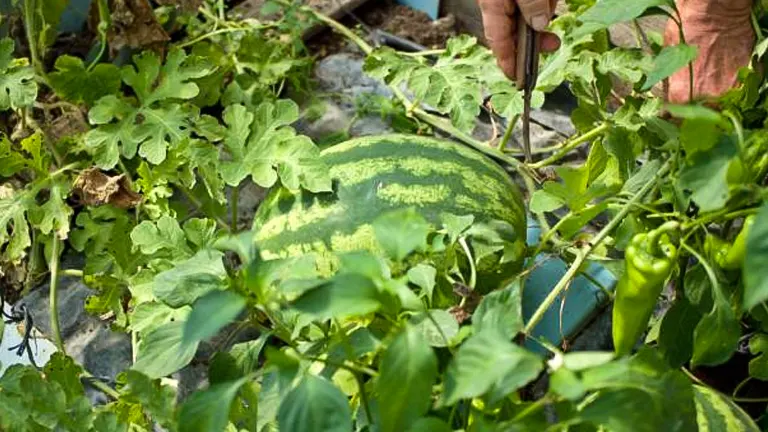
Pruning is a vital practice in managing watermelon plants to enhance yield and fruit quality. Effective pruning techniques ensure that the plant’s energy is directed towards the most productive vines and fruits, leading to healthier plants and better harvests.
Selective Vine Pruning
Watermelon plants typically produce multiple vines, but not all contribute equally to fruit development. Selective vine pruning focuses the plant’s energy on the most productive vines.
- Technique: Identify the primary vine and a few strong secondary vines. Prune away other vines to reduce competition for nutrients. Typically, keeping the main vine and two to three secondary vines is optimal.
- Scientific Insight: Research shows that selective vine pruning can increase fruit size and yield by up to 20%, as the plant’s resources are concentrated on fewer, more productive vines.
Leaf Pruning
Removing older, less productive leaves can significantly improve air circulation and reduce the risk of moisture-related diseases, such as powdery mildew. Improved air circulation also facilitates better sunlight penetration, which is essential for fruit ripening.
- Technique: Regularly inspect the plant and remove older, yellowing leaves, especially those near the base. Ensure that leaves covering the fruits are pruned to allow sunlight exposure.
- Scientific Insight: Enhanced air circulation from leaf pruning can reduce disease incidence by up to 30%, leading to healthier plants and higher fruit quality.
Fruit Thinning
Watermelon plants often set more fruits than they can support to full maturity. Thinning out smaller or imperfect fruits early ensures that the remaining fruits grow larger and are of higher quality.
- Technique: Inspect the plant when fruits are small (about the size of a tennis ball). Remove smaller, deformed, or excessive fruits, leaving 2-3 healthy fruits per vine.
- Scientific Insight: Fruit thinning can increase the average fruit weight by up to 25%, as the plant’s resources are allocated to fewer, more robust fruits.
Timing and Tools for Pruning
- Timing: Pruning should begin early in the growing season and continue as needed. Early pruning (within the first few weeks of vine growth) helps shape the plant and establish a strong structure.
- Tools: Use clean, sharp pruning shears to make precise cuts. Sterilize tools between uses to prevent the spread of disease.
Pruning Techniques and Benefits
| Pruning Technique | Purpose | Method | Scientific Benefits |
|---|---|---|---|
| Selective Vine Pruning | Focuses energy on productive vines | Keep primary and 2-3 secondary vines | Increases fruit size and yield by up to 20% |
| Leaf Pruning | Improves air circulation, reduces disease | Remove older, yellowing leaves | Reduces disease incidence by up to 30% |
| Fruit Thinning | Ensures larger, higher-quality fruits | Remove smaller, deformed fruits | Increases average fruit weight by up to 25% |
Additional Considerations
- Monitoring Plant Health: Regularly monitor plant health and growth. Adjust pruning practices based on the plant’s response and environmental conditions.
- Environmental Factors: Consider the climate and weather conditions. In humid climates, more aggressive leaf pruning might be necessary to prevent diseases, while in arid climates, maintaining some leaf cover can help conserve soil moisture.
- Nutrient Management: Combine pruning with proper nutrient management. Pruned plants may have different nutrient needs, so adjust fertilization accordingly to support new growth and fruit development.
Common Mistakes to Avoid in Fertilizing Watermelons
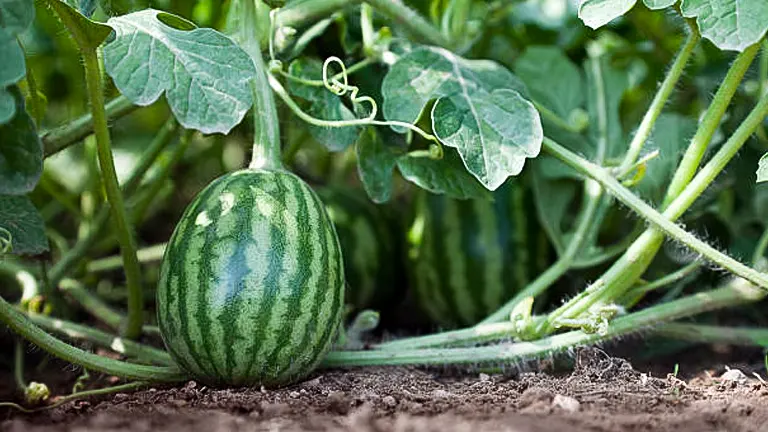
Fertilization is a critical aspect of watermelon cultivation, but it can easily go wrong if not done carefully. Here are some common mistakes to watch out for:
- Over-Fertilization: Applying too much fertilizer can lead to nutrient burn, where the salts from the fertilizers damage the plant roots, leading to stunted growth or even death of the plant. Always follow the recommended rates and observe plant response before adding more.
- Ignoring Soil pH: Soil pH greatly affects nutrient availability. A pH that is too high or too low can lock nutrients in the soil, making them inaccessible to your plants. Regularly test soil pH and adjust as necessary to maintain it within the optimal range of 6.0 to 6.8.
- Inappropriate Timing: Applying fertilizers at the wrong time can waste resources and even harm your plants. Ensure that the timing of your fertilizer application matches the plant’s growth stages for maximum effectiveness.
Safety and Environmental Considerations
When fertilizing watermelons, it is crucial to consider both safety and the environmental impact:
- Safe Handling of Fertilizers: Always wear appropriate protective gear when handling chemical fertilizers, such as gloves and masks, to avoid skin contact and inhalation of dust or fumes.
- Preventing Runoff: Fertilizer runoff can lead to eutrophication of nearby water bodies, which harms aquatic life. Apply fertilizers in calm weather, avoid over-irrigation, and use containment strategies such as planting cover crops around watermelon fields.
- Sustainable Practices: Consider using organic fertilizers or integrating practices like crop rotation and organic mulching, which not only supply nutrients but also enhance soil health and biodiversity, reducing the need for chemical inputs.
Related Post
- How to Build a Barn: A Step-by-Step Guide for Beginners
- How to Build a Sustainable Compost Bin: Easy and Eco-Friendly DIY
- How to Fertilize Bougainvillea: A Complete Guide for Stunning Blooms
- How to Fertilize Apple Trees: Essential Tips for a Bountiful Harvest
- How to Fertilize Lemon Trees: Secrets for Thriving Citrus
- How to Fertilize Avocado Tree: A Step-by-Step Guide for Lush Growth
- 10 Best Bow Saws to Buy in 2024: Top Picks for the Money
- Best Miter Saw For Beginners
- Top 10 Pruning Saws to Buy in 2024: Best for the Money
- 7 Best Pocket Chainsaw
Conclusion
Maximizing the yield of your watermelon crop through expert fertilization techniques involves much more than just applying nutrients. It requires a deep understanding of the plant’s needs, careful timing, and precise application methods, coupled with regular soil health monitoring. By avoiding common mistakes and considering safety and environmental impacts, you can ensure that your watermelon plants thrive and produce the best possible fruits.
FAQs
- What is the best time to start fertilizing watermelon plants?
Begin fertilizing watermelon plants at the planting stage using a balanced fertilizer that is slightly higher in phosphorus to promote strong root development. Continue with nitrogen-rich fertilizers as the vines develop, and switch to potassium-rich fertilizers during flowering and fruit set. - How often should I apply fertilizer to my watermelon plants?
Fertilize watermelons every 3-4 weeks during the growing season. The frequency can vary based on soil fertility, which is why it’s crucial to conduct a soil test before planting to tailor the fertilization schedule to your soil’s specific needs. - Can I use organic fertilizers for my watermelon plants, and what are the benefits?
Yes, organic fertilizers such as composted manure, bone meal, and seaweed are excellent for watermelons. They release nutrients slowly, improve soil structure, support microbial life, and reduce the risk of nutrient runoff, making them an environmentally friendly choice. - What are the signs of over-fertilization in watermelon plants?
Signs of over-fertilization include yellowing or browning of leaf tips, stunted growth, and a lower fruit yield. Over-fertilization can lead to nutrient burn, where excess salts build up and damage the plant roots. - How does the plant-to-plant spacing affect fertilizer application in watermelon farming?
Adequate spacing ensures that each watermelon plant receives enough nutrients without competition. It also allows for better distribution of fertilizer and reduces the risk of disease spread among plants. Typically, a spacing of about 2 feet within rows and 6-8 feet between rows is optimal. - What role does potassium play in fertilizing watermelon plants?
Potassium is crucial for water regulation and overall plant health, particularly during the fruiting stage. It helps improve the size, color, and sweetness of the fruits, as well as the plant’s resistance to diseases and stress. - Is it necessary to adjust the soil pH before fertilizing watermelons?
Yes, adjusting the soil pH to between 6.0 and 6.8 is crucial for optimal nutrient uptake. A pH outside this range can lock nutrients in the soil, making them unavailable to the plants, regardless of how much fertilizer you apply. - How can I minimize environmental impact while fertilizing watermelon plants?
To minimize environmental impact, use organic fertilizers where possible, practice precise application techniques to avoid runoff, and consider using cover crops or buffer zones to absorb any excess nutrients. Also, avoid over-irrigation to prevent fertilizer leaching.
With the right knowledge and techniques, fertilizing your watermelon garden can lead to unparalleled yields and delicious fruits. Embrace these expert tips and watch your watermelons thrive!

Kristine Moore
Forestry AuthorI'm Kristine Moore, a seasoned garden landscaping professional with over 30 years of experience. My extensive career has been dedicated to transforming outdoor spaces into stunning, sustainable landscapes. With a deep understanding of horticulture, design principles, and environmental stewardship, I have become a respected figure in the field, known for creating harmonious, visually appealing, and eco-friendly gardens. My commitment to excellence and continuous learning in landscaping trends and techniques has solidified my reputation as an expert in garden design and implementation.













Leave your comment